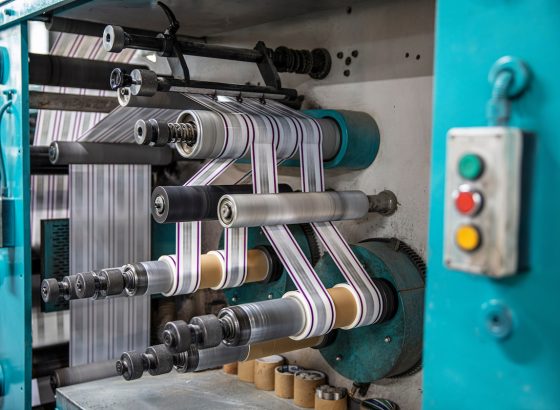Web handling solutions have transformed how we think and handle mass production to create high-quality and consistent products. From battery manufacturing to tag and label cutting, web handling processes are the key to reducing waste during the manufacturing process for a variety of textiles.
In this comprehensive guide to web handling basics, we’ll cover the technical aspects related to web handling, including how web handling systems work, common web handling processes, and its wide range of applications.
What is Web Handling?
Web handling is the method of guiding, controlling and converting web materials such as paper, nonwovens, packaging, metal, films, and textiles in large quantities.
Unlike other forms of manufacturing, web handling, also known as roll-to-roll processing, handles a continuous stream of materials instead of individual sheets or products. Optimizing the web handling process helps reduce waste and allows for consistent quality, resulting in profitable web processing—and much of these optimizations can be done by introducing automation to the converting line.
How Web Handling Works
Web handling works to move web materials through roll-to-roll processing. To comprehensively describe web handling, we must establish some basic terminology. Web systems employ the use of various components including, but not limited to:
Winding systems: systems designed to unwind and rewind the web, marking the beginning and end of the web handling process.
Slitting systems: a process of slicing web material into more manageable, better rolls before the rewinding stage.
Tension controls: using either open or closed-loop tension control, these systems ensure that tension remains consistent throughout the web–reducing the risk of wrinkling and other web defects.
Rotary dies: cylindrical drums that rotate with precision blades to cut materials into uniform shapes.
Vision systems: image-based inspection designed to identify and help correct defects in the web.
Load cells: transducer which converts tension into electronic signals, which can be controlled to maintain web handling precision.
Idler rollers: cylindrical rollers that aid in the consistent, speedy movement of the web along the web path.
Heat transfer rollers: specialized roll that cools or heats the web to a required temperature, facilitating effective web processes.
Other precision rolls: unique rolls designed to apply coatings, laminate, transfer heat, etc.
Converting lines incorporate these tools, such as winding, guiding, tension, slitting and die cutting to create a fully optimized process. From unwind to rewind, these individual components work together to create consistent, error-free products.
Common Web Handling Processes
Manufacturers can incorporate various tools into their process to effectively transform raw web material into final products. The different processes include but are not limited to, coating, slitting, cutting, stamping, laminating, plating and more. Each process requires a component carefully chosen to meet the needs of the material and converting line.
Web Handling Applications
Web handling is used for various applications across the globe. Industries such as packaging, nonwovens, metals, batteries, foils, plastic films, paper and more can benefit from optimized web processing methods. Products such as diapers, feminine hygiene products, tissue paper, paper towels, disposable masks, and product labels start as unprocessed web before making it onto the shelves of our local supermarkets.
Conclusion
In summary, web handling is a common process used for a variety of manufacturing applications. Because web handling involves many components, from tension check-points and web guiding, to precision cutting and winding, the opportunities for upgrading and improving a converting line are countless.
Interested in learning more? For additional information on the basics of web handling and the more advanced concepts that help our clients work better, faster and smarter, contact us today.
